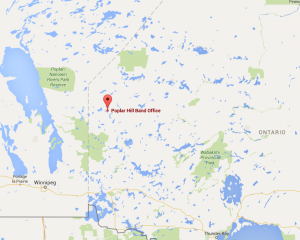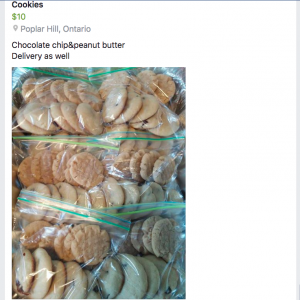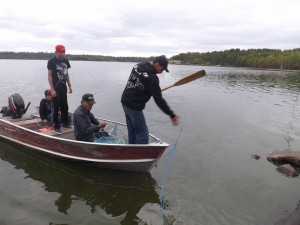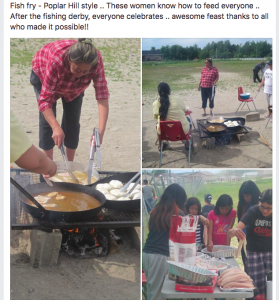By Jennifer Leask
A modern digital tool like social media likely isn’t the first thing that comes to mind when people consider how to preserve First Nations cultures in Northern Ontario, but sites like Facebook and MyKnet.Org are doing just that – and more – for some communities.
When Howard Moose wants to get the word out about a skills training program, he uses two tools: the community radio station, where he shares the information in his language, and on Facebook where he shares the poster and information in English. Moose is the Ontario Works Employment Worker for Poplar Hill First Nation. Through this role, Moose offers skills and employment training opportunities in the community.
“We have Facebook groups where we can communicate with the community, with the young generation, to get a hold of them, to send them out announcements,” said Moose in an interview.

Poplar Hill First Nation
For the Ojibway people who live in , which is 700 km North of Thunder Bay, Ontario, a recent improvement in bandwidth speeds has allowed them to use sites like Netflix for entertainment, and Facebook for just about everything else – from buying and selling items to organizing social and cultural events.

Shirts for sale on Facebook
A quick look at the closed Obseahdekong Nishnabs Facebook group for the community shows sale items from home made cookies, a DVD collection, and even letting people know when the playoff hockey squares were all filled up for fundraising. Selling meals at lunch and supper time is a popular use of the local site.

Cookies for Sale on Facebook
Moose recently offered a skills training session on barber training skills, and posted it on the community site on Facebook. He said it was popular because some people in the community wanted to get haircuts, while others wanted to develop the hands-on skills of the trade. Community work experience placements are also posted, as well as other Ontario Works programming in Poplar Hill.
An added benefit to connecting the younger generation in the community of 600 people with the skills they need, is that it also connects them with their traditional way of life. Poplar Hill is teaching the knowledge of how to make a tikinagan, through the teaching of an Elder from another community, a tikinagan is one of the traditional ways to bundle up and safely carry a baby, said Moose.

Training on Setting a Fish Net
It’s important to note that Facebook was not the first social media application to connect people in these communities. Long before Facebook, Moose used a service developed and provided by the community’s regional non-profit First Nations technology organization (KNET). The social media service introduced in 1999 is called MyKNet.Org.
This service was created after people living in these remote communities in Northern Ontario established their digital infrastructure connections to the Internet. Communication applications like Facebook are only possible when a community has access to a reliable broadband connection. Building and operating that connection is a job the people living in these regions had to do themselves. Getting First Nations communities in Northern Ontario online started with Poplar Hill First Nation and other Keewaytinook Okimakanak First Nation communities creating the Kuhkenah Network (KNET) in 1994.
It started as an email service around 1995, according to Jesse Fiddler, who works in Data Management for the First Nation council, which established KNET and continues to manage the service on behalf of its owners, several First Nations communities in the region. “At the same time as we were putting Internet into the communities and into the schools, part of [KNet’s] early objectives were [providing] literacy and keyboarding skills,” Fiddler told FirstMile.ca in an interview. As a result, KNet started offering free email addresses.
In 1999, was started, offering an early social media-style home page service for Northern communities, similar to the sites which were taking off in the rest of North America. The MyKNet.Org service was carefully designed to serve the low-bandwidth communities, optimizing the email client and counting every byte and kilobyte it took to load a page, trimming down the options so the service could work over slow connections.
Fiddler, a Sandy Lake First Nation band member who now lives in Sioux Lookout, remembers the original MyKNet.Org site as easy enough for Elders to get online, but flexible enough that if people wanted to get fancy with HTML, they could.
“Back when people were learning how to use the internet there wasn’t a lot of places to go to do that…MyKnet.Org was the first social media site for everybody before social media was a term,” said Fiddler.
At its peak, the site had up to 2,000 updated pages each day, and approximately ten million visits each month.
Angie Morris, a member of the Muskrat Dam First Nation, was one of the first users of the MyKNet.Org home pages. She described herself as a “guinea pig” of the original service when it started. She worked with the designers to make sure the site was easy enough for anyone to use. Historically, First Nations have an oral history, said Morris, and while the incorporation of digital communication has been going on for years, it was helped along by KNet.org.

Firefighting Course Graduates
Community announcements, community auctions, fundraising for events were all posted on KNet.org for years. In a small community like Muskrat Dam, of the 220 members, 90 of them had home pages, said Morris. Now that Facebook has been adopted, even more members are online – as many as 140.
Like Moose, Morris sees the benefit of communicating with young people through the site: “One of the biggest ways I use Facebook is sharing information about various things, one of them being our culture and the history of First Nations in our area.”
She moved to Sioux Lookout so her daughter could attend high school, and now keeps in touch with her community through Facebook. That’s where she saw photos, videos, and posts from a friend at Aboriginal Head Start in Muskrat Dam: Elders were invited to set nets in an area with an abundance of whitefish, and the community was invited to participate in the traditional way of catching fish.

Celebrating After the Fishing Derby
“It was very interactive…it involved everyone in the community like [my friend’s] son who is not even two, all the way up to Elders who are 70 plus,” said Morris.
Despite the availability of new social media applications like Facebook, early KNet adopters like Morris and Fiddler still use MyKNet.Org for longer blog posts, putting the link into their Facebook feeds. Everyone interviewed for this story agreed that Facebook has helped to connect their communities in both modern ways and to traditional ways.
Morris said once a fiber optic connection was installed in Muskrat Dam, social media use took off. “There’s a lot more activity, there’s a lot more people posting pictures of fishing and hunting and that kind of thing,”
This community story was reviewed and approved by the Poplar Hill community members featured. It was produced with the support of a grant from the (CIRA).
